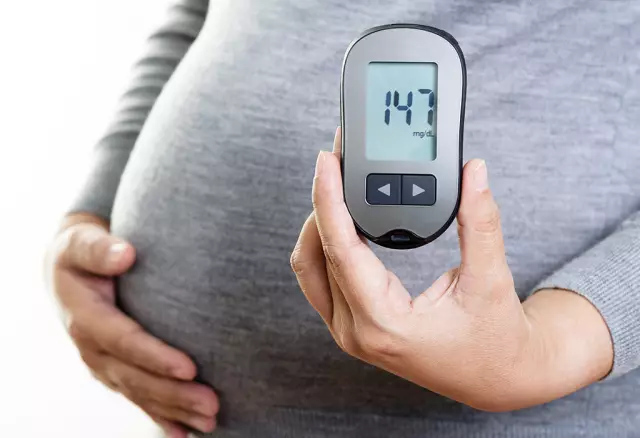- Author Rachel Wainwright [email protected].
- Public 2024-01-15 19:51.
- Last modified 2025-11-02 20:14.
What to do if your legs are swollen with diabetes
The content of the article:
-
Treatment of leg edema in diabetes mellitus
- General recommendations
- Folk remedies
- Why do legs swell with diabetes?
- Associated signs
- Video
If a patient has swollen legs with diabetes mellitus, this cannot be ignored, since the lack of proper treatment can lead to the development of severe consequences (diabetic foot), up to the need for amputation.
The swollen lower extremities of diabetics become more vulnerable to injury and secondary infection, which are dangerous because in such patients, healing and tissue regeneration is slower.

Swelling of the legs is common in diabetes mellitus, this problem cannot be ignored
Edema can develop with both type 1 and type 2 diabetes.
Treatment of leg edema in diabetes mellitus
First of all, constant monitoring of the patient's blood glucose level is required. Maintaining normal glucose levels reduces the likelihood of swelling.
In the presence of spasms in the lower extremities with swelling, myotropic antispasmodics may be prescribed. Antiseptic agents are used to treat the affected skin.
Depending on the condition and associated pathologies, patients may be assigned:
- diuretic drugs;
- antihypertensive drugs;
- anti-inflammatory drugs.
General recommendations
With swelling of the lower extremities, the patient is shown walking. It is usually recommended to walk at least 3 kilometers per day, however, the patient should avoid physical strain. Physiotherapy techniques, therapeutic exercises can also be used.
It is recommended to include more fresh vegetables, fruits, herbs, lactic acid products in the patient's diet. In addition to sugar, too salty, spicy, fatty, fried foods should be limited or excluded from the diet.
Massage with the use of massage and essential oils is effective; it is best done before bedtime.
With the development of skin diseases, it is necessary to treat them immediately.
In addition, diabetic patients are advised to:
- avoid prolonged sitting or standing;
- regularly treat the nails and cuticles on the fingers of the lower extremities with tweezers and a file (however, do not cut the nails too short);
- regularly examine the legs for microtrauma;
- after washing the lower limbs, treat them with a nourishing cream;
- wear comfortable shoes with a small, stable heel, as well as hosiery made from natural materials;
- rest with raised legs.
Folk remedies
The main treatment, after consultation with the attending physician, can be supplemented with traditional medicine methods.
Popular folk remedies prepared according to the following recipes will help to remove puffiness:
- Infusion of oats, ginseng root or primrose. 1 tablespoon of dry raw materials (any of these plants) is poured with 1 glass of boiling water, insisted for at least 30 minutes, filtered and drunk throughout the day.
- Infusion cuff close. 10 g of dry grass is poured into 200 ml of boiling water and insisted for several hours. Filter the finished infusion and take 1/4 cup 4 times a day.
- Kidney tea. Ready pharmacy dry collection of herbs (3.5 g) is poured with 1 glass of boiling water, insisted for 45 minutes (before that, you can hold the liquid for 15 minutes in a water bath), filter and drink 0.5 cups warm 2 times a day before meals.
Why do legs swell with diabetes?
The cause of swelling of the lower extremities in diabetes is a complex of changes occurring in the tissues of the lower extremities in this disease. These include damage to blood vessels, joints, nerve fibers.
The vascular wall, altered against the background of the disease, passes blood plasma into the intercellular space, where it accumulates, as a result of which edema is formed.
Another reason for the formation of puffiness in patients with diabetes mellitus is kidney damage (diabetic nephropathy). In this case, there is a violation of the filtration of blood plasma in the renal glomeruli in the process of urination and a retention of fluid in the human body, which can lead to the development of edema.
Risk factors include:
- the presence of diseases of the urinary system;
- Varicose veins;
- period of pregnancy in women;
- violation of water-salt metabolism;
- diet disorders;
- excess weight;
- the presence of bad habits;
- wearing too tight shoes.
Attention! Photo of shocking content.
Click on the link to view.
Associated signs
In most cases, patients with diabetes have swelling of the upper and / or lower extremities, and in some patients, the lower abdomen and internal organs. Swelling is especially common in the lower legs (sole, ankle, lower leg).
In addition to puffiness, there may be other signs of a pathological condition:
- hyperemia of the skin of the lower extremities (especially when wearing shoes and socks made of unnatural materials), or, on the contrary, pallor and cyanosis;
- numbness of the limbs, reduced sensitivity to mechanical stress;
- burning sensation in the fingers;
- strong throbbing in the limbs;
- dry skin, calluses, cracked heels;
- hair loss on the legs.
Swelling in one leg may be more pronounced than in the other. Often in patients there is a deformation of the toenails.
Signs of kidney pathology in diabetes:
| Primary | Secondary |
| Albuminuria | Increased concentration of blood urea nitrogen, decreased glomerular filtration rate |
| Frequent urination at night | Nausea, vomiting, weakness in the morning, pallor of the skin, anemia |
| High blood pressure | Reducing the need for diabetes medications |
In the absence of adequate treatment, there is an increase in the degree of unpleasant sensations in the affected limb, pain in the legs may increase when walking.
Video
We offer for viewing a video on the topic of the article.

Anna Aksenova Medical journalist About the author
Education: 2004-2007 "First Kiev Medical College" specialty "Laboratory Diagnostics".
Found a mistake in the text? Select it and press Ctrl + Enter.






